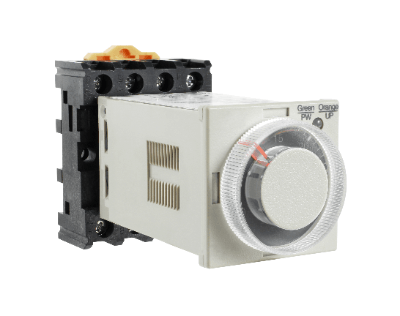What Is an Analog Timer?

An analog timer (time relay) is a device that turns a contact on or off after a certain set time from the time it receives an input.
Analog timers offer the advantage of easily adjusting the set time using a dial. However, on the other hand, there is a risk of error associated with their analog nature. Analog Timers can not only switch ON/OFF only once, but can also turn ON/OFF periodically or change the input/output values, such as turning the output ON or OFF upon receiving an ON input.
Uses of Analog Timers
Analog Timers can be used to run a device or stop a device after a certain amount of time has elapsed. Analog Timers are classified according to several modes of operation and should be selected according to when you want to switch the output.
1. Pedestrian Push-Button Signals
After pressing the button, the traffic light switches from red to blue.
2. Automatic Doors
When a person approaches a door, a sensor triggered and the door opens. After a certain period, when the person leaves the door, the door closes.
3. Cuckoo Clock
At a predetermined time, the gimmick operates and the pigeon inside repeatedly unfolds and retracts.
4. Coin-Operated Dryer
When money is inserted, the dryer operates for a predetermined time.
Principle of Analog Timer
Analog Timer consists of four parts: a clock part, a power supply part, an input part, and an output part. In the case of the power start method, the Analog Timer is activated after voltage is applied to the power supply section.
The input part receives an input signal from the outside, the clock part measures the time, and when the set time is reached, the output part sends out an output signal to the outside. The user can set the set time as desired. When the set time is reached, it is called time-up.
There are several types of operation modes for the Analog Timer:
- ON-delay operation
Output turns ON with a time delay after input ON. - Off-delay operation
Output turns OFF with a time delay after input OFF. - Flicker Operation
Output turns ON/OFF periodically by time difference after input ON. - Interval Operation
Output is turned off by time difference after input ON. - Star-delta operation
For electric motors.
ON/OFF switching is performed by switching contacts. The fifth type, known as “star-delta operation,” is difficult to visualize solely from its name. Therefore, we will provide a brief introduction here. “Star” and “delta” are named after the circuit shape of an electric motor’s windings, and the timer is controlled by turning the star/delta contacts ON and OFF.
How to Select an Analog Timer
1. Display Accuracy
The degree to which a unit of measure is to be displayed on a timer should be determined according to the application. For example, if you are measuring cooking time, you do not need to measure in tenths of seconds; seconds are sufficient. On the other hand, if the timer is to be used for industrial purposes or experiments, it must be able to measure in tenths of seconds.
2. Measurement Range
The measurement range of the timer must be confirmed. If you need to measure for a long period of time, you need to select a timer that can measure for a long period of time. Depending on the timer, for example, a day may be counted after 24 hours, or 25:00, 26:00, and so on.
3. Ease of Operation
Ease of use is important, including button placement and digital display. In particular, the placement of the buttons can lead to timing discrepancies between ON and OFF. Therefore, it is necessary to try several times when selecting a timer. The displayed numbers should also be in a font that is easy to read and understand.
4. Durability
For long-term use, it is important to select a durable product. Rugged and durable timers are needed, especially for industrial applications and outdoor use. Since cold or heat may degrade the functionality of the product, check in advance “where it will be used” and how it will be affected in that location.
5. Price
Select a timer that fits your budget. It is important to select a cost-effective product that has the necessary functions but eliminates unnecessary features. Even with the same functions, there are minor differences in durability and materials, so care should be taken when comparing multiple timers.
6. Reviews and Evaluations
Before purchasing, it is a good idea to check reviews and evaluations by other users. By referring to the opinions and evaluations of people who have actually used the timer, it will be easier to find the right timer for you. It is recommended that you check the opinions of users who have purchased the product for the same purpose as you.